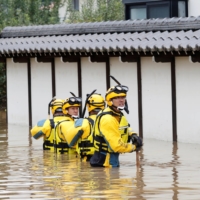As the world tries to price the cost of climate change, Japan’s second-largest nonlife insurer, MS&AD, foresees the potential rise in claim payments in 2050 from current levels to be anywhere between 5% and 50%.
Sompo Holdings, the No. 3 nonlife insurer, also plans to announce a similar estimate in August but with plenty of caveats, its officials say.
Others, including industry leader Tokio Marine & Nichido Fire Insurance, are wary of even producing estimates, citing a lack of data.
“We know our analysis isn’t perfect,” said Yasumasa Kanie, manager of MS&AD Insurance’s sustainability section.
“But there may never be a correct answer. It’s better than nothing.”
The wide range produced by MS&AD illustrates the difficulty of pricing climate costs, and underscores the challenge financial institutions face in meeting pressure from investors for more disclosure.
Calculating climate costs is no easy task even for Japanese insurers, who are armed with sophisticated models to predict the course and intensity of typhoons and the damage they could cause.
“We have experience estimating payments for insurance sold during a particular year,” said Hiroo Shimada, deputy general manager at Tokio Marine’s sustainability division.
“But doing scenario analysis without clarity on how the climate could change 50 years from now, and how that could affect the number of typhoons that hit Japan, is a different story.”
Japanese regulators are still learning their way in setting rules on disclosure, lagging their counterparts in countries such as Britain and France who have already announced plans to conduct stress tests incorporating climate risks.
Domestic financial institutions have thus been allowed to go slow. But that is changing, as Japan joined its Group of Seven counterparts this month in backing moves to force banks and firms to disclose their exposure to climate risks.
Among the world’s most disaster-prone countries, Japan is already seeing a surge in heavy rain, typhoons and flooding, which the government has blamed partly on climate change.
Total damage by flooding hit a record ¥2.2 trillion in 2019. Unprecedented torrential rain in southern Japan last July flooded 13,000 hectares of land, costing nonlife insurers ¥106 billion in payments.
The government estimates that average temperatures in Japan will rise by up to 4.5 degrees Celsius toward the end of this century, which could double or quadruple the number of floodings.
When announcing last week the Bank of Japan’s plan to boost funding for fighting climate change, Gov. Haruhiko Kuroda warned that climate change could exert an “extremely large impact” on the economy.
While the need for disclosure appears imminent, various factors make insurers, including those in Europe and the United States, wary of doing so.
Among them is the difficulty of modelling the impact of rising temperatures on cash flows over such a long time frame, as well as a lack of uniform, comparable global rules on what assumptions they can base their projections on.
Policymakers have urged companies to use recommendations made in 2017 by the Task Force on Climate-related Financial Disclosures. But the TCFD itself warned that more tools, data and methods must be developed for climate-related scenario analysis to work for a broader range of industries.
Setting global standards could turn out to be a complex and controversial process that could take years, as climate change affects countries in different ways, analysts say.
Europe has suffered heat and drought, while Australia and some U.S. states such as California have been hit by wildfires.
In Japan, flooding caused by typhoons and heavy rain make up roughly 70% of all natural disasters, and is partly why MS&AD’s analysis is based on the impact of typhoons.
“I’m really surprised MS&AD has decided to disclose its analysis,” said Eiji Kubo, director at S&P Global Ratings Japan.
“Even now, one or two typhoons could abruptly increase losses to the scale of ¥100 billion,” he said. “When it’s so hard to predict costs several years from now, what’s the point trying to come up with projections for 2030 or 2050?”
In a time of both misinformation and too much information, quality journalism is more crucial than ever.
By subscribing, you can help us get the story right.
SUBSCRIBE NOW



